No edit summary |
No edit summary |
||
| Line 116: | Line 116: | ||
[[File:Hindenburg Disaster - real footage of the terrible crash 1937|thumb|center|584 px]][[File:The Hindenburg disaster|thumb|center|583 px]][[File:Hindenburg Crash in 1937 - Original Footage!|thumb|center|581 px]] |
[[File:Hindenburg Disaster - real footage of the terrible crash 1937|thumb|center|584 px]][[File:The Hindenburg disaster|thumb|center|583 px]][[File:Hindenburg Crash in 1937 - Original Footage!|thumb|center|581 px]] |
||
| + | ==Videos== |
||
Revision as of 19:55, 10 June 2019
The Hindenburg Disaster occurred on May 6th, 1937. The world's largest Zeppelin, the LZ 129 Hindenburg was attempting to land at the Lakehurst Naval Air Base in New Jersey after completing it's first Frankfurt-United States transatlantic flight of 1937 and it's 18th transatlantic flight altogether. Suddenly, at 7:25, the airship caught fire, and within 30-40 seconds, the airship was completely destroyed.
36 people were killed in the disaster (35 passengers and one ground crew member).
Flight
Hindenburg began its last flight on May 3, 1937, carrying 36 passengers and 61 officers, crew members, and trainees. It was the airship’s 63rd flight. The ship left the Frankfurt airfield at 7:16 PM and flew over Cologne, and then crossed the Netherlands before following the English Channel past the chalky cliffs of Beachy Head in southern England, and then heading out over the Atlantic shortly after 2:00 AM the next day.
Hindenburg followed a northern track across the ocean passing the southern tip of Greenland and crossing the North American coast at Newfoundland. Headwinds delayed the airship’s passage across the Atlantic, and the Lakehurst arrival, which had been scheduled for 6:00 AM on May 6th, was postponed to 6:00 PM.
By noon on May 6th the ship had reached Boston, and by 3:00 PM Hindenburg was over the skyscrapers of Manhattan in New York City. The ship flew south from New York and arrived at the Naval Air Station at Lakehurst, New Jersey at around 4:15 PM, but the poor weather conditions at the field concerned the Hindenburg’s commander, Captain Max Pruss, and also Lakehurst’s commanding officer, Charles Rosendahl, who sent a message to the ship recommending a delay in landing until conditions improved. Captain Pruss departed the Lakehurst area and took his ship over the beaches and coast of New Jersey to wait out the storm. By 6:00 PM conditions had improved; at 6:12 Rosendahl sent Pruss a message relaying temperature, pressure, visibility, and winds which Rosendahl considered “suitable for landing.” At 6:22 Rosendahl radioed Pruss “Recommend landing now,” and at 7:08 Rosendahl sent a message to the ship strongly recommending the “earliest possible landing.”
Landing Attempt
Disaster Strikes
At 7:25, without warning, the Hindenburg's hydrogen caught fire. Small flames ripped through the top of the ship, close
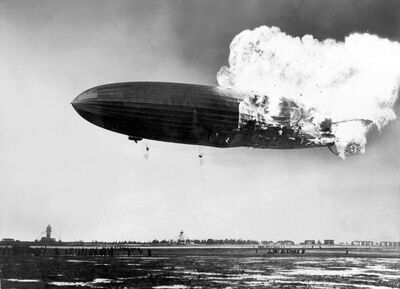
The Hindenburg's stern explodes, 5 seconds after the fire breaks in front of the tail.
to the tailfins. Five seconds later, the airship was rocked by a tremendous explosion as one of the rear hydrogen gas bags was ignited by the flames. Everybody on board the ship was thrown off their feet by the sudden jolt. The back of the airship was quickly engulfed in fire, and the ship (as it was losing hydrogen) began to fall to the ground tail-first. The tail's metal ripped, melted, and collapsed as it fell.
The landing crew on the ground scattered for cover. Reporters and civilians underneath the ship screamed and ran away in panic. The huge crowd of reporters and civilians watching the landing from a safe distance broke out screaming as they watched in horror as the airship burned. Other landing crew members ran out onto the field, towards the burning wreckage.
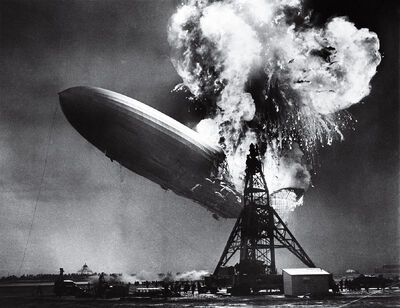
Sam Shere's Famous Photo of The Hindenburg Disaster
Inside the Hindenburg, chaos took over. In the passenger's lounge and observation decks, smoke burst through the hallways, the air turned as hot as a furnace, and tables and chairs slid backward and smashed. The screaming passengers were sent tumbling down as the ship lurched to a high angle. The crew was thrown back too, in the gondola. The crew inside the ship's hull ran for their lives as the fire spread. Lots of crew members are burned alive as the fire tears through the Hindenburg. Thick smoke poured through the passenger quarters, followed by flames that began to spread rapidly throughout the passengers quarters as flaming debris fell through the ceiling and into the cabins. Many passengers still inside their cabins were trapped and killed. One by one each of the hydrogen gas bags ignited or caught fire. Before the Hindenburg hit the ground, another explosion rocked the inside of the ship, as the diesel fuel was ignited by the fire. A horizontal explosion suddenly ripped all the way through the axial corridor, shooting flames through the nose, and killing almost all the 12 crew members in the nose, with others been severely burnt. As the fire spread on the fabric roof of the ship and flames ripped through the
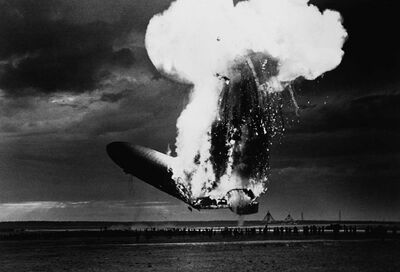
The Hindenburg Falls out of the Sky as the ship's tail is engulfed in fire.
nose, the ship's tail crashed to the ground, crushing land crew member, Allen Hagaman, killing him almost instantly. One of the Hindenburg's propellers whipped violently through the air and broke apart as one of the still-idling engine cars crashed to the ground. Just before the ship hit the ground, flames tore into the passenger's quarters, setting the lounges on fire, as the cabins continued to burn. Many people were burnt or set on fire. At this point, the passengers began to open and smash the windows on both sides of the ship, to create a method of escaping the fire. Passengers began to jump for their lives. Some people jumped too high, accidentally falling to their deaths. Many others timed their jumps when the ship got lower and lower to the ground.

The Hindenburg hits the ground as flames shoot out of the nose.
The crew members did the same. They opened up emergency exit doors (that had been put on the hull just in case of fire) and jumped to the ground, lept out of the burning nose's windows, escaped through the engine car's stairway, while others ripped through the fabric of the ship before the flames reached them, and fell to the ground. However, almost all of the crew members inside the hull were killed as it became engulfed. Witnesses on the ground reported seeing flaming bodies falling from the burning hull, and some passengers on fire jumping from the windows.
As the ship grew closer and closer to the ground, the area above the passenger quarters began to become engulfed in flames. The ceiling's in the passenger's cabins and lounges began to collapse exposing the hellish flames above, which began to fall into cabins, killing and trapping many of them. Around this time, the crew's gondola crashed to the ground. Captain Pruss and the rest of the crew began to escape by smashing open the windows on the bridge. However, flaming debris fell into the cabin, severely burning
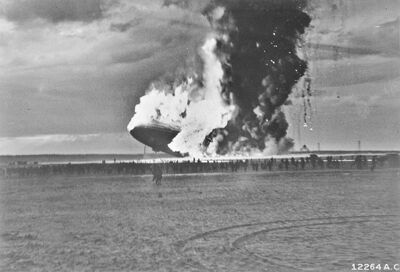
The airship's bow begins to burn up.
Pruss and killing a few members in the gondola. However, the gondola balanced the ship level for a few seconds, therefore allowing the majority of the passengers to escape. However, most people who escape were on the port side of the ship, as a light wind pushed the fires away from the port side, towards the starboard side. The people on the starboard side were far less lucky, as the wind pushed the fire towards them. Many people managed to escape by jumping out the starboard windows, but the fire engulfed the starboard side within seconds, killing most of the people trapped inside the port side. The Hindenburg's logos are completely burned up on the port and starboard side at this point.

The Hindenburg is completely engulfed in flames, just before the frame collapses.
Also, around the same time, the starboard side began to become engulfed, the loading stairway (where the passengers board or depart the ship) shook open as the ship vibrated, allowing many passengers to escape by climbing down the stairs to the ground, just like disembarking on a normal journey's end. However, the escape stairway became jammed a few seconds later by falling debris, sealing the fate of most of those still trapped on board.
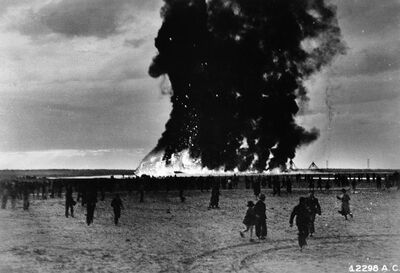
The Hindenburg collapses
As the staircase became jammed, the port side was finally engulfed in flames, killing most of the people still inside, as the final people jumped out the windows. The whole airship was now completely engulfed in flames. A second later, the hydrogen finished burning, though the framework of the ship, the diesel fuel, and everything else still was engulfed. With no hydrogen, gravity took over, and the nose began to fall to the ground, bending the melted frame in the process. As the nose crashed the ground, the Hindenburg collapsed, destroying everything and reducing the airship to a pile of tangled metal.
The whole catastrophe took place in 30-40 seconds.
Aftermath
The ground crew rushed towards the blazing wreckage to save people still trapped inside the wreckage of the Hindenburg, and assist the survivors. The Hindenburg's hydrogen had all burned off, though the diesel fuel was still burning. Around 29 people on board the airship are dead at this point, along with ground crew member, Allen Hagaman, the soul-death on the ground. Many passengers who miraculously survived were still trapped inside the burning hull. Navy crew members rushed back towards the burning airship, crew members grabbed firehoses and hooked them up to hydrants close to the mooring masts. They immediately began to hose down the fire, desperately trying to get it under control.
Crew members attempted to help survivors who had suffered from burns and injuries. Very brave crew members also rushed into the burning hull and attempted to find survivors. Some found many survivors who had miraculously survived the fire, while all that others could do was body recovery.
Sirens screeched through the airfield as the Lakehurst Fire Department arrived on the scene.
Over 50-60 ambulances began to immediately respond to catastrophe, though they all arrived at different times. Firefighters, medical workers, ground crew members, and even bystanders help carry injured and grievously burned survivors into the hangar where the Hindenburg was supposed to be housed in overnight. Inside the hangar, a temporary hospital was set up where emergency staff at the landing field helped care for survivors, trying to bandage up the wounds and giving them drugs to dull the pain. Whenever an ambulance arrived, paramedics took people from the hangar and took them to hospitals for treatment. Some injuries were so severe, ambulances had to take people over an hour-long trip to a superior hospital in New York City. One of these survivors was crew member Ernst Lehmann, who had been fatally injured. He died from his burns the next day.
Six people died late that night in hospitals, making the final death count 36.
Impact
The Hindenburg Disaster went down in history as the most infamous airship crash of all time, and one of the most

The burned-up remains of the Hindenburg
iconic aviation disasters of all time. This wasn't the deadliest airship disaster of all time, but why it was so famous was the whole world was there to see it. There were thousands of witnesses on the ground that day, there were hundreds of photographs taken of the disaster, Herbert Morrison's radio broadcast was heard across the nation, and the whole disaster was caught on film for everyone to see. Showing the scale of the catastrophe, it immediately began to spark a huge effect on the public and airships.
Cause
The cause of the Hindenburg's fire was the ship's hydrogen gas that gave the ship its flotation
Ruled-Out Causes of Ignition
Mechanical Failure
Many people at the time thought that the Hindenburg's hydrogen may have caught fire because of a mechanical failure of the airship. Mechanical failures could have included faulty wiring in the crew's quarters or passenger's quarters, like lighting. There also might have been damaged for the storm the airship passed through earlier, and the rain at Lakehurst. However, this cause was ruled out, as there was no report of any mechanical failures on the airship. Everything seemed to be working fine.
Lightning Strike
Lightning was a probable cause for the disaster because there were rainstorms in the area. Some people assumed that lightning might have struck the back of the ship, creating enough electricity to blow up one of the hydrogen gas bags. This would have been a very likely cause, except for the fact that thousands of witnesses were there that day. Not one of them reported a lightning strike on the airship or saw any lightning in the skies. Also, there would have been a huge crack as the electricity hit, and the explosion would have been much bigger. In reality, the flames first appeared out of the back of the ship first, then followed by an explosive reaction. With lightning, there would be no flames, just a huge explosion.
Engine Fuel Leak
Many people believed that the airship's diesel fuel might have been leaking. It had been the other cause of many hydrogen airship fires and a few members of the crew thought they could smell something like gasoline. The theory is that the engine was malfunctioning, causing hot gas to leak out of the fuel tank into the airship. The hot fuel hit the hydrogen gas bag, setting it on fire and triggering the disaster. Another theory is that the fuel leak caused the engine to catch on fire first, then the fumes spread to hydrogen bag, igniting it. This seemed like a plausible explanation, but the thing that debunked this theory was that all the witnesses on the ground reported that the fire started around the top of the airship, nowhere near the engine or fuel tank. If either had caught fire, the fire would have started at the bottom of the airship. Even though it seemed plausible, this one theory was enough to find it not true.
Sabotage
Many people thought at that time, that sabotage was the most likely explanation. In fact, the Hindenburg's captain, Max Pruss, Commander Rosendahl, the commander of the Lakehurst Naval Airbase, and some members of the Zeppelin company, all thought it was sabotage. Hugo Eckener mentioned the possibility of sabotage as the cause of the disaster, but in his opinion, there was not much evidence to support this theory.
The main reason the Hindenburg might have been a target for sabotage, was because it was being used as a symbol for Nazi propaganda because of the Swastika's painted on the tailfins. As the Nazi's were hated all over Europe, some people would have liked to see the airship destroyed.
There were a few threatening letters overtime that threatened the zeppelin would blow up. The Zeppelin company took threats very seriously. However, none of these sabotage plots were carried out because the saboteurs were caught and arrested. But, there was only one possible saboteur on board the Hindenburg that seemed like the best choice to blame in the 1930's: Joeseph Spah.
Spah was a US acrobat who was traveling home on board the Hindenburg. He had brought a home video camera to film his journey. He also had brought a dog on board that he was going to give to his grandchildren as a present. He had permission to go into the crew-only cargo hold to feed him. This is where many investigators began to grow suspicious. Spah had access to the ship's hull and he was an acrobat. Being an acrobat, he could easily have climbed up the ship's metal framework to plant an explosive device, such as a time bomb or a grenade.
Spah was interrogated and charged with terrorism. Spah was asked about his background, the journey itself, and where he was before and during the disaster. However, Spah was found "not guilty" because of two reasons. First, Spah wouldn't go through all the trouble to plant a bomb in the top section of the back of the ship, because the crew would get suspicious. He could have easily planted a bomb in the gondola of the ship, and still have a deadly effect. However, the fire and the explosion would have come out the rear side of the ship, not the top in front of the tail. Second, Spah had absolutely no motive. He was not an anti-nazi, a soldier, or had any criminal record. According to the evidence on his video camera, he was just a normal passenger like any other. So, Spah was found innocent, and the police apologized for charging him.
However, in the 1960s another possible saboteur was found by author, A. A. Hoehling; Eric Spehl. Spehl was a crew member and an airship rigger that died in the fire. However, when investigating his background, A.A Hoelhling found a possible motive; Spehl was anti-Nazi. Hoehling had other theories to back his theory up
- Spehl's girlfriend had communist beliefs and anti-Nazi connections.
- The fire's origin was near the catwalk running through Gas Cell 4, which was an area of the ship generally off-limits to anyone other than Spehl and his fellow riggers.
- Hoehling's claim that Chief Steward Heinrich Kubis told him the Chief Rigger Ludwig Knorr noticed damage of Cell 4 shortly before the disaster.
- Rumors that the Gestapo had investigated Spehl's possible involvement in 1938.
- Spehl's interest in amateur photography, making him familiar with flashbulbs that could have served as an igniter.
- The discovery by representatives of the New York Police Department (NYPD) Bomb Squad of a substance that was later determined to likely be "the insoluble residue from the depolarizing element of a small, dry battery." (Hoehling postulated that a dry cell battery could have powered a flashbulb in an incendiary device.)
- The discovery by the Federal Bureau of Investigation (FBI) agents of a yellow substance on the valve cap of the airship between cells 4 and 5 where the fire was first reported. Although initially suspected to be sulfur, which can ignite hydrogen, it was later determined that the residue was actually from a fire extinguisher.
- A flash or a bright reflection in gas cell 4, that crew members near the lower fin had seen just before the fire.
Hoelhling published a book about his theory called, "Who Destroyed the Hindenburg?" In his book, it tells how Spehl might have been able to carry out the sabotage. It says in the book, that Spehl's plan was not to murder anyone on board. Spehl's plan was to destroy the Hindenburg with nobody but himself on it, to show the Nazi's that there would be a war against them. The ship would have been landed, so everybody would be off, though the newsreel cameras would capture the destruction as it happened. Unfortunately, Spehl's plan was accidentally botched, because the Hindenburg's landing was delayed by over 12 hours. Horrified, Spehl realized he had no way to defuse the bomb or change the time of detonation, so instead of exploding on the ground and hurting no one, the bomb exploded and set the airship on fire while it was still in the air during the landing, therefore resulting in the disaster and his death.
Interested, Hoehling's theory was investigated to find out if Spehl could have been the potential saboteur. They checked his background history and his ties with Nazi-Germany. They searched his old home for weapons. However, they couldn't find any signs that Spehl destroyed the airship. However, Spehl's possible story was published into a novel by Michael Mooney in 1972 (though Spehl's name and other historical names were changed) and was later adapted into a movie in 1975, starring George C. Scott. However, after much investigation, Spehl was found "not guilty" too. He was the last potential suspect, therefore debunking the sabotage theory.
Also, scientists say that if it was a bomb, the explosion would have been much bigger, and there would be bigger flames leaking before the explosion, so this theory was debunked. However, some workers at the Zeppelin company actually hoped that it was sabotage because that would mean that it wasn't the airship's fault that it burst into flames. However, everybody mostly believed that it was indeed the airship's fault and that hydrogen airships were inherently unsafe (this was confirmed multiple times over the year).
Engine Sparks
Another possible cause was that the engine might have been malfunctioning. It's predicted the electrical batteries might have been setting off sparks accidentally, spraying them into the ship's hull, igniting the hydrogen gas bag, or a possible hydrogen leak (as the ship was tail heavy). This seemed plausible, except for the fact that the sparks from the engine were not hot enough to ignite the hydrogen.
Paint Theory
This recent theory was proposed in 1996. It has been rumored that the Hindenburg with a chemical that was highly used in rocket fuel. This theory predicts that the paint may have been ignited by a static spark on the hull, causing the paint to catch fire first, then blow up the hydrogen gas bag. This theory was debunked multiple times because the fire would have been way fiercer if the paint was like that. Also, even if it was painted on, with the fabric surrounding the ship would still burn at the same rate with or without it.
Smoking Lounge Leak
Most Likely Cause of Ignition-Hydrogen Leak and Spark
Static Discharge Spark
St Elmo's Fire
Footage
Videos
Gallery
Trivia
- Most hydrogen airship fires have more casualties than survivors. There were three main factors that saved more people on board the Hindenburg than other airship disasters. First of all, most of the passengers and some crew members in the passenger's quarters were close to the windows. That meant they had a quicker way to escape. Second, the airship stalled when the crew car hit the ground, keeping the airship level for a few seconds, therefore allowing the majority of the passengers still inside to escape. Third, hydrogen burns sharply upwards, instead of spreading in a random direction like diesel fuel. Even those who were still trapped after the ship collapsed were safe if they were in areas close to hydrogen, though most of those survivors pulled out were still badly burnt.
- The Hindenburg has been accidentally thought that the voyage with disaster was the ships maiden voyage. This was not true. It had flown over 70 times before the disaster. It also wasn't the deadliest airship disaster of all time, but it was so famous because it was caught on camera.




